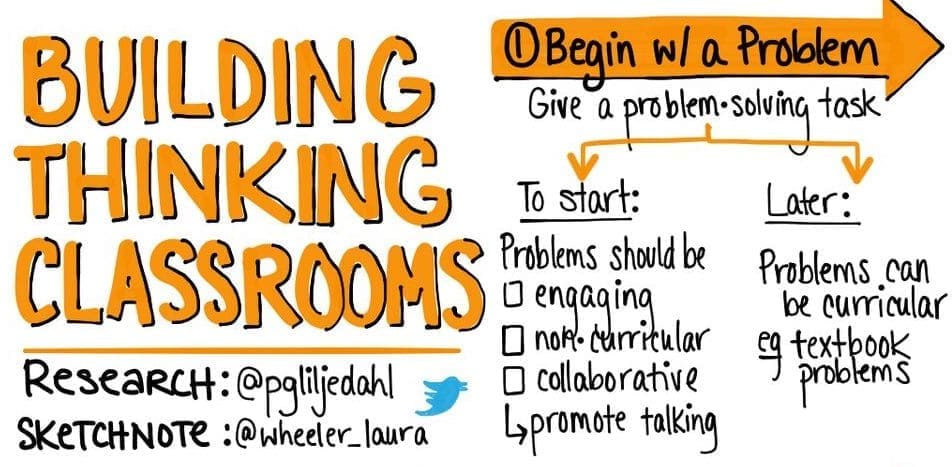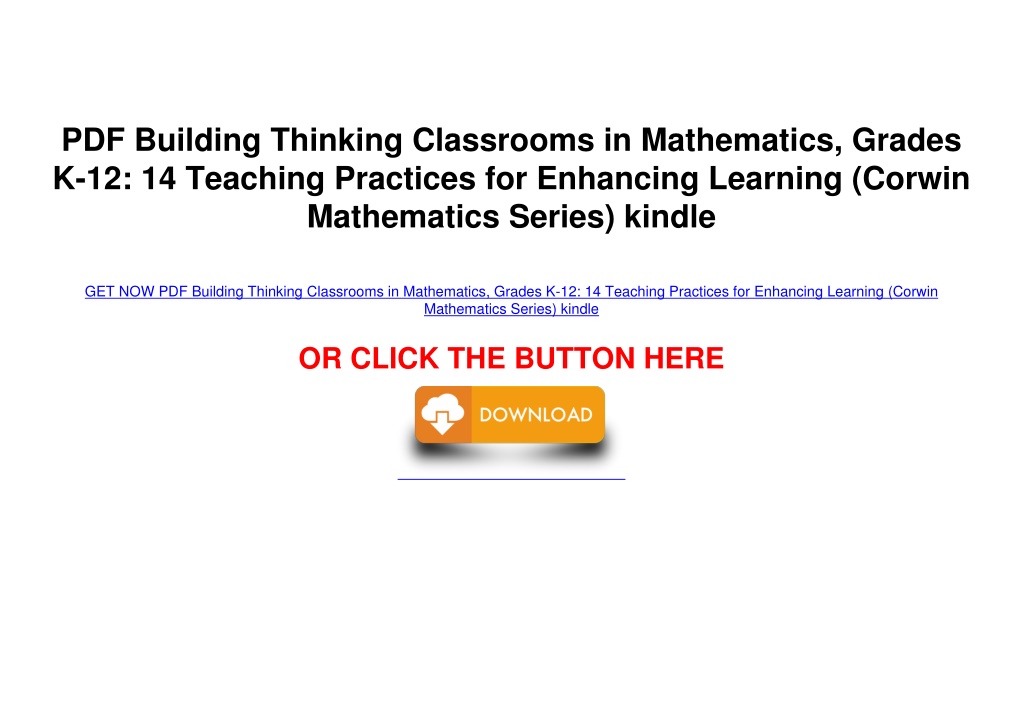Building Thinking Classrooms 14 Practices Pdf

Imagine a classroom buzzing not with the drone of rote memorization, but with the lively chatter of students deeply engaged in mathematical problem-solving. Desks are replaced by whiteboards, vertical surfaces adorned with colorful scribbles, diagrams, and collaborative attempts at cracking complex concepts. The air crackles with curiosity and the quiet satisfaction of intellectual discovery. This isn't a utopian fantasy; it's the reality being fostered by the principles outlined in Peter Liljedahl's "Building Thinking Classrooms in Mathematics, Grades K-12: 14 Teaching Practices for Enhancing Learning".
This article delves into the transformative power of Liljedahl's Building Thinking Classrooms (BTC) framework, particularly focusing on the freely available "14 Practices" PDF. This document has become a cornerstone for educators seeking to move beyond traditional teaching methods and cultivate genuine mathematical thinking in their students. We will explore the core ideas, practical applications, and the impact this approach is having on classrooms worldwide.
The Genesis of a Thinking Revolution
Peter Liljedahl, a Professor of Mathematics Education at Simon Fraser University, embarked on a 15-year research journey. This extensive study sought to understand what truly makes students think in the mathematics classroom. His observations of hundreds of classrooms, across various grade levels and demographics, led him to identify specific pedagogical practices that consistently fostered deeper engagement and understanding.
Liljedahl noticed that many traditional methods, despite good intentions, often inadvertently hindered student thinking. He identified common culprits like reliance on note-taking, passive lectures, and problem-solving routines that prioritized memorization over genuine understanding. His research led him to question these established norms and search for alternatives.
The culmination of this research is the Building Thinking Classrooms framework, a set of 14 practical and research-backed teaching practices. These practices are designed to systematically disrupt unproductive habits and create an environment where thinking flourishes.
Unpacking the 14 Practices
The 14 Practices aren't just a collection of isolated strategies; they're a cohesive system designed to work together. They address key areas of classroom instruction, from the types of tasks assigned to the way students work together and the methods used for assessment.
1. Starting with Thinking Tasks
One of the foundational principles is to begin each lesson with a challenging and engaging thinking task. These tasks are designed to be non-routine and require students to grapple with mathematical concepts in a meaningful way.
These tasks are deliberately chosen to be accessible to all students, regardless of their prior knowledge. They offer multiple entry points and encourage students to explore and experiment.
2. Using Vertical Non-Permanent Surfaces (VNPS)
Moving away from traditional desks and notebooks, the BTC framework advocates for the use of vertical, non-permanent surfaces like whiteboards. This seemingly simple change has a profound impact on student collaboration and engagement.
VNPS encourage students to share their thinking publicly, fostering a sense of collective problem-solving. The erasable nature of whiteboards also reduces the fear of making mistakes, promoting risk-taking and experimentation.
3. Working in Random Groups
Strategic grouping is another key element. Liljedahl suggests using random group formations to break down social barriers and encourage collaboration among all students.
Random groups ensure that students work with a diverse range of peers, exposing them to different perspectives and problem-solving approaches. This also prevents the formation of fixed social hierarchies within the classroom.
4. Problem Solving Before Instruction
The BTC framework encourages students to grapple with problems before receiving direct instruction. This allows them to develop their own understanding of the concepts and identify areas where they need support.
By struggling with problems first, students are more receptive to instruction and better able to connect new information to their existing knowledge. This approach also promotes a deeper and more lasting understanding.
5. Strategic Use of Hints and Extensions
Providing timely and targeted hints and extensions is crucial for supporting students as they work through challenging tasks. Hints should be designed to nudge students in the right direction without giving away the solution.
Extensions offer opportunities for students who finish early to delve deeper into the concepts and explore related ideas. This keeps all students engaged and challenged.
6. Consolidation of Learning
The consolidation phase is a critical part of the learning process. This involves bringing the class together to share their solutions, discuss different approaches, and formalize the key concepts.
Effective consolidation requires careful planning and facilitation. The teacher guides the discussion, highlighting key insights and addressing common misconceptions.
7. Formative Assessment Strategies
BTC emphasizes the importance of ongoing formative assessment. This involves gathering information about student learning throughout the lesson and using it to adjust instruction accordingly.
Formative assessment can take many forms, from observing student interactions to collecting quick feedback on whiteboards. The key is to use this information to inform teaching decisions and support student learning.
8. Purposeful Questioning
Effective questioning is essential for promoting student thinking. Teachers should ask questions that encourage students to explain their reasoning, justify their answers, and make connections between different concepts.
Purposeful questioning also helps teachers to identify areas where students are struggling and provide targeted support.
9. Celebrating Mistakes
In a Thinking Classroom, mistakes are seen as opportunities for learning and growth. Teachers create a culture where students feel safe taking risks and making mistakes.
By analyzing mistakes, students can gain a deeper understanding of the underlying concepts and identify areas where they need to improve.
10. Cultivating a Growth Mindset
A growth mindset is the belief that intelligence and abilities can be developed through effort and learning. Teachers can foster a growth mindset by praising effort and persistence, rather than innate talent.
When students believe that they can improve, they are more likely to persevere through challenges and achieve their full potential.
11. Establishing Clear Routines and Expectations
Clear routines and expectations are essential for creating a structured and supportive learning environment. This allows students to focus on the task at hand without being distracted by procedural issues.
Routines should be established for everything from entering the classroom to transitioning between activities. This helps to create a sense of predictability and stability.
12. Building a Culture of Collaboration
Collaboration is a cornerstone of the Thinking Classroom. Students are encouraged to work together, share their ideas, and learn from each other.
Teachers can foster a culture of collaboration by providing opportunities for students to work on group projects, participate in class discussions, and offer peer support.
13. Providing Meaningful Feedback
Feedback should be specific, actionable, and focused on helping students improve. Teachers should avoid providing generic praise or criticism.
Meaningful feedback helps students to understand their strengths and weaknesses and identify areas where they need to focus their efforts.
14. Reflection and Self-Assessment
Encouraging students to reflect on their learning and assess their own understanding is a powerful way to promote metacognition. This helps students to become more aware of their own thinking processes and develop strategies for learning more effectively.
Reflection can take many forms, from journaling to participating in class discussions. The key is to provide students with opportunities to think about their learning and identify areas where they can improve.
The "14 Practices" PDF: A Practical Guide
The freely available "14 Practices" PDF serves as a practical guide for educators looking to implement the Building Thinking Classrooms framework. It provides a concise overview of each practice, along with concrete examples and practical tips for implementation.
The PDF is designed to be accessible and easy to use. It's a valuable resource for teachers at all levels, from those just starting to explore the framework to those who are already experienced in implementing these practices.
Impact and Testimonials
The Building Thinking Classrooms framework has been adopted by educators around the world, and the results have been consistently positive. Teachers report increased student engagement, improved problem-solving skills, and a deeper understanding of mathematical concepts.
Many educators have shared their experiences online, highlighting the transformative impact of the BTC framework on their classrooms. They praise the practical nature of the practices and the positive effect they have on student learning.
"Implementing the Building Thinking Classrooms practices has completely transformed my math classroom. My students are now actively engaged in problem-solving and are demonstrating a much deeper understanding of the concepts." - A High School Mathematics Teacher
Conclusion: Embracing a Thinking Future
The Building Thinking Classrooms framework offers a powerful alternative to traditional teaching methods. By embracing these 14 practices, educators can create classrooms where students are actively engaged in thinking, problem-solving, and learning.
The journey toward building a thinking classroom is a continuous process of experimentation, reflection, and refinement. But the rewards are well worth the effort: a classroom filled with curious, engaged, and empowered learners ready to tackle the challenges of the future.
As we look toward the future of education, it's clear that fostering critical thinking skills will be more important than ever. The Building Thinking Classrooms framework provides a roadmap for educators who are committed to creating a more engaging and effective learning environment for all students.


















